半导体导论翻译
- 格式:doc
- 大小:49.50 KB
- 文档页数:5

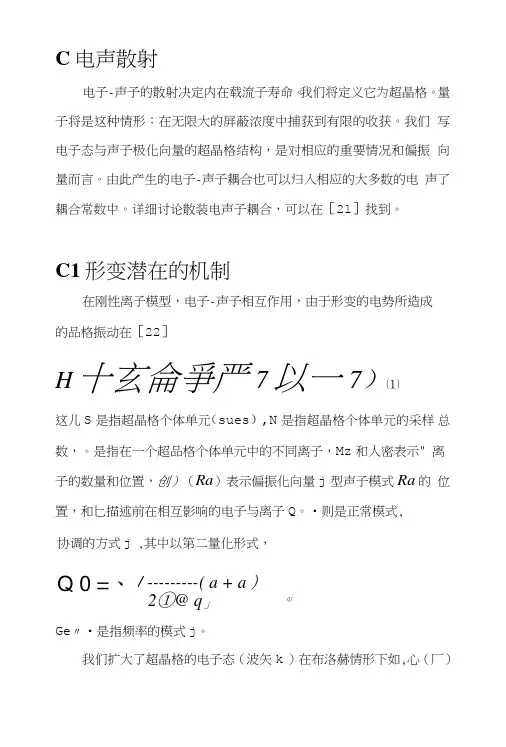
C电声散射电子-声子的散射决定内在载流子寿命。
我们将定义它为超晶格。
量子将是这种情形:在无限大的屏蔽浓度中捕获到有限的收获。
我们写电子态与声子极化向量的超晶格结构,是对相应的重要情况和偏振向量而言。
由此产生的电子-声子耦合也可以归入相应的大多数的电声了耦合常数中。
详细讨论散装电声子耦合,可以在[21]找到。
C1形变潜在的机制在刚性离子模型,电子-声子相互作用,由于形变的电势所造成的品格振动在[22]H十玄侖爭严7以一7)⑴这儿S是指超晶格个体单元(sues),N是指超晶格个体单元的采样总数,。
是指在一个超品格个体单元中的不同离子,Mz和人密表示" 离子的数量和位置,创)(Ra)表示偏振化向量j型声子模式Ra的位置,和匕描述前在相互影响的电子与离子Q。
•则是正常模式,协调的方式j,其中以第二量化形式,Q 0 =、/ --------- ( a + a )2①@ q」qjGe〃•是指频率的模式j。
我们扩大了超晶格的电子态(波矢k )在布洛赫情形下如,心(厂)是个例子,V表示和大部分相关。
瓦(厂)=工心(“也)%”(厂) 这儿心定义为在大多数情况下保持不变。
这里g.,・指的是z 组成的超 晶格倒数矢量。
矩阵元的H" 之间的两个电子态与波向量k 和F 是 nj Eg ,3s7nD 九 lq + g ②这儿% ⑷三J 〃3厂%(沪/,2)0心心)这儿匕皿指的是°邙口离子或阴离子)的组成部分,偏振波矢量q 的大部分模式V 和Mg 〃总质量的绝大多数晶胞都在相应的大部分材 料中。
当中的+(-)符号表示上述方程的声子吸收(释放)过程。
注 意,在EQN(3)中的Dv,v (q )仅仅是对于大多数材料的电声了耦合常 数而言。
为光学声子中心附近区域D (q )的q 近似为独立的。
而对于声 学模式,D (q )是成正比的q,与相称常数被称为形变机制。
C2极性光散射由< 約 H el _ph | k >=-———s2 叫 NM cellqHx对于III-V型半导体,光学声子促进了材料中的大多数单元的离子间的相互运动,从而导致了偶级子震荡。

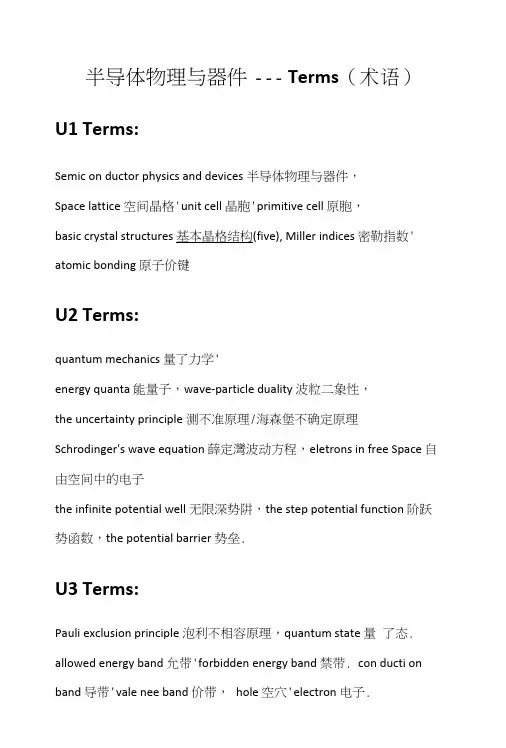
半导体物理与器件--- Terms(术语)U1 Terms:Semic on ductor physics and devices 半导体物理与器件,Space lattice 空间晶格'unit cell 晶胞'primitive cell 原胞,basic crystal structures 基本晶格结构(five), Miller indices 密勒指数' atomic bonding 原子价键U2 Terms:quantum mechanics 量了力学'energy quanta 能量子,wave-particle duality 波粒二象性,the uncertainty principle测不准原理/海森堡不确定原理Schrodinger's wave equation 薛定灣波动方程,eletrons in free Space 自由空间中的电子the infinite potential well 无限深势阱,the step potential function 阶跃势函数,the potential barrier 势垒.U3 Terms:Pauli exclusion principle 泡利不相容原理,quantum state 量了态. allowed energy band 允带'forbidden energy band 禁带. con ducti on band 导带'vale nee band 价带,hole 空穴'electron 电子.effective mass 有效质量.density of states function 状态密度函数,the Fermi-Dirac probability function 费米■狄拉克概率函数' the Boltzmann approximation 波尔兹曼近彳以‘ the Fermi energy 费米能级.U4 Terms:charge carriers 载流子'effective density of states function 有效族犬态密度函数,intrinsic 本征的,the intrinsic carrier concentration 本征载流子浓度'the intrinsic Fermi level 本征费米能级.charge n eutrality 电中性状态'compe nsated semic on ductor 补偿半导体‘ degenerate 简并的,non-degenerate 非简并的'position of E F费米能级的位置U5 Terms:drift current 漂移电流,diffusion current 扩散电流,mobility 迁移率,lattice scattering 晶格散身寸,ionized impurity scattering 电离杂质散射'velocity saturation饱和速度’conductivity 电导率‘resistivity 电阻率.graded impurity distribution 杂质梯度分布'the induced electric field 感生电场'the Einstein relation 爱因斯坦关系, the hall effect 霍尔效应U6 Terms:non equilibrium excess carriers 非平衡过剩载流子'carrier generation and recombination 载流子的产生与复合'excess minority carrier 过剩少子,lifetime 寿命'low-level injection 小注入,ambipolar transport 双极输运'quasi-Fermi energy 准费米能级.U7 Terms:the space charge region 空间电荷区'the built-in potential 内建电势,the built-in potential barrier 内建电势差,the space charge width 空间电荷区宽度,zero applied bias 零偏压,reverse applied bias 反偏'on esided jun ction 单边突变结.U8 Terms:the PN junction diode PN 结二极管,minority carrier distribution 少数载流子分布'the ideal-diode equation 理想二极管方程,the reverse saturation current density 反向饱和电流密度.a short diode 短二极管,generation-recombination current 产生・复合电流,the Zener effect 齐纳效应,the avalanche effect 雪崩效应,breakdown 击穿.U9 Terms:Schottky barrier diode (SBD)肖特基势垒二极管,Schottky barrier height 肖特基势垒高度.Ohomic contact 欧姆接触'heterojunction 异质纟吉'homojunction 单质纟吉,turn-on voltage 开启电压,narrow-bandgap 窄带隙'wide-bandgap 宽带隙,2-D electron gas 二维电子气U10 Terms:bipolar transistor 双极晶体管,base基极,emitter发射极,collector集电极. forward active regi on 正向有源区'in verse active region 反向有源区' cut-off 截止,saturation 饱和,current gain电流增益'common・base 共基,commorvemitter 共身寸.base width modulation 基区宽度调制效应,Early effect 厄利效应'Early voltage厄利电压Ull Terms:Gate 栅极,source 源极,drain 漏极'substrate 基底. work function difference 功函数差threshold voltage 阈值电压'flat-band voltage 半带电压enhancement mode 增强型'depletion mode 耗尽型strong inversion 强反型'weak inversion 弱反型,transconductance 跨导'l-V relationship 电流■电压关系。
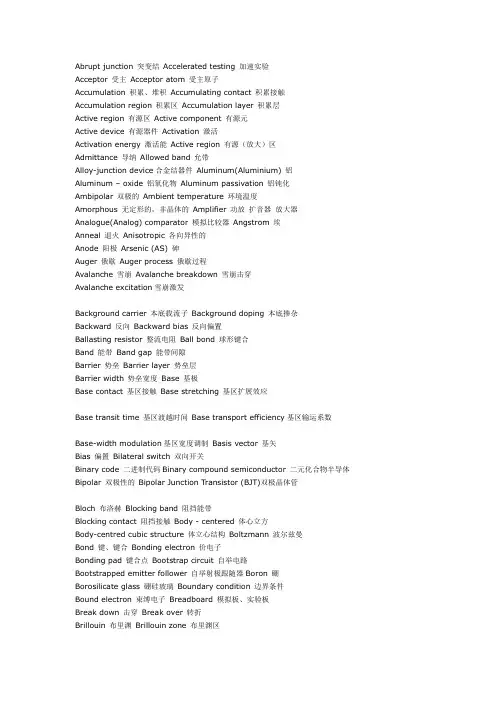
Abrupt junction 突变结Accelerated testing 加速实验Acceptor 受主Acceptor atom 受主原子Accumulation 积累、堆积Accumulating contact 积累接触Accumulation region 积累区Accumulation layer 积累层Active region 有源区Active component 有源元Active device 有源器件Activation 激活Activation energy 激活能Active region 有源(放大)区Admittance 导纳Allowed band 允带Alloy-junction device合金结器件Aluminum(Aluminium) 铝Aluminum – oxide 铝氧化物Aluminum passivation 铝钝化Ambipolar 双极的Ambient temperature 环境温度Amorphous 无定形的,非晶体的Amplifier 功放扩音器放大器Analogue(Analog) comparator 模拟比较器Angstrom 埃Anneal 退火Anisotropic 各向异性的Anode 阳极Arsenic (AS) 砷Auger 俄歇Auger process 俄歇过程Avalanche 雪崩Avalanche breakdown 雪崩击穿Avalanche excitation雪崩激发Background carrier 本底载流子Background doping 本底掺杂Backward 反向Backward bias 反向偏置Ballasting resistor 整流电阻Ball bond 球形键合Band 能带Band gap 能带间隙Barrier 势垒Barrier layer 势垒层Barrier width 势垒宽度Base 基极Base contact 基区接触Base stretching 基区扩展效应Base transit time 基区渡越时间Base transport efficiency基区输运系数Base-width modulation基区宽度调制Basis vector 基矢Bias 偏置Bilateral switch 双向开关Binary code 二进制代码Binary compound semiconductor 二元化合物半导体Bipolar 双极性的Bipolar Junction Transistor (BJT)双极晶体管Bloch 布洛赫Blocking band 阻挡能带Blocking contact 阻挡接触Body - centered 体心立方Body-centred cubic structure 体立心结构Boltzmann 波尔兹曼Bond 键、键合Bonding electron 价电子Bonding pad 键合点Bootstrap circuit 自举电路Bootstrapped emitter follower 自举射极跟随器Boron 硼Borosilicate glass 硼硅玻璃Boundary condition 边界条件Bound electron 束缚电子Breadboard 模拟板、实验板Break down 击穿Break over 转折Brillouin 布里渊Brillouin zone 布里渊区Built-in 内建的Build-in electric field 内建电场Bulk 体/体内Bulk absorption 体吸收Bulk generation 体产生Bulk recombination 体复合Burn - in 老化Burn out 烧毁Buried channel 埋沟Buried diffusion region 隐埋扩散区Can 外壳Capacitance 电容Capture cross section 俘获截面Capture carrier 俘获载流子Carrier 载流子、载波Carry bit 进位位Carry-in bit 进位输入Carry-out bit 进位输出Cascade 级联Case 管壳Cathode 阴极Center 中心Ceramic 陶瓷(的)Channel 沟道Channel breakdown 沟道击穿Channel current 沟道电流Channel doping 沟道掺杂Channel shortening 沟道缩短Channel width 沟道宽度Characteristic impedance 特征阻抗Charge 电荷、充电Charge-compensation effects 电荷补偿效应Charge conservation 电荷守恒Charge neutrality condition 电中性条件Charge drive/exchange/sharing/transfer/storage 电荷驱动/交换/共享/转移/存储Chemmical etching 化学腐蚀法Chemically-Polish 化学抛光Chemmically-Mechanically Polish (CMP) 化学机械抛光Chip 芯片Chip yield 芯片成品率Clamped 箝位Clamping diode 箝位二极管Cleavage plane 解理面Clock rate 时钟频率Clock generator 时钟发生器Clock flip-flop 时钟触发器Close-packed structure 密堆积结构Close-loop gain 闭环增益Collector 集电极Collision 碰撞Compensated OP-AMP 补偿运放Common-base/collector/emitter connection 共基极/集电极/发射极连接Common-gate/drain/source connection 共栅/漏/源连接Common-mode gain 共模增益Common-mode input 共模输入Common-mode rejection ratio (CMRR) 共模抑制比Compatibility 兼容性Compensation 补偿Compensated impurities 补偿杂质Compensated semiconductor 补偿半导体Complementary Darlington circuit 互补达林顿电路Complementary Metal-Oxide-Semiconductor Field-Effect-Transistor(CMOS)互补金属氧化物半导体场效应晶体管Complementary error function 余误差函数Computer-aided design (CAD)/test(CAT)/manufacture(CAM) 计算机辅助设计/ 测试/制造Compound Semiconductor 化合物半导体Conductance 电导Conduction band (edge) 导带(底) Conduction level/state 导带态Conductor 导体Conductivity 电导率Configuration 组态Conlomb 库仑Conpled Configuration Devices 结构组态Constants 物理常数Constant energy surface 等能面Constant-source diffusion恒定源扩散Contact 接触Contamination 治污Continuity equation 连续性方程Contact hole 接触孔Contact potential 接触电势Continuity condition 连续性条件Contra doping 反掺杂Controlled 受控的Converter 转换器Conveyer 传输器Copper interconnection system 铜互连系统Couping 耦合Covalent 共阶的Crossover 跨交Critical 临界的Crossunder 穿交Crucible坩埚Crystal defect/face/orientation/lattice 晶体缺陷/晶面/晶向/晶格Current density 电流密度Curvature 曲率Cut off 截止Current drift/dirve/sharing 电流漂移/驱动/共享Current Sense 电流取样Curvature 弯曲Custom integrated circuit 定制集成电路Cylindrical 柱面的Czochralshicrystal 直立单晶Czochralski technique 切克劳斯基技术(Cz法直拉晶体J)Dangling bonds 悬挂键Dark current 暗电流Dead time 空载时间Debye length 德拜长度De.broglie 德布洛意Decderate 减速Decibel (dB) 分贝Decode 译码Deep acceptor level 深受主能级Deep donor level 深施主能级Deep impurity level 深度杂质能级Deep trap 深陷阱Defeat 缺陷Degenerate semiconductor 简并半导体Degeneracy 简并度Degradation 退化Degree Celsius(centigrade) /Kelvin 摄氏/开氏温度Delay 延迟Density 密度Density of states 态密度Depletion 耗尽Depletion approximation 耗尽近似Depletion contact 耗尽接触Depletion depth 耗尽深度Depletion effect 耗尽效应Depletion layer 耗尽层Depletion MOS 耗尽MOSDepletion region 耗尽区Deposited film 淀积薄膜Deposition process 淀积工艺Design rules 设计规则Die 芯片(复数dice)Diode 二极管Dielectric 介电的Dielectric isolation 介质隔离Difference-mode input 差模输入Differential amplifier 差分放大器Differential capacitance 微分电容Diffused junction 扩散结Diffusion 扩散Diffusion coefficient 扩散系数Diffusion constant 扩散常数Diffusivity 扩散率Diffusion capacitance/barrier/current/furnace 扩散电容/势垒/电流/炉Digital circuit 数字电路Dipole domain 偶极畴Dipole layer 偶极层Direct-coupling 直接耦合Direct-gap semiconductor 直接带隙半导体Direct transition 直接跃迁Discharge 放电Discrete component 分立元件Dissipation 耗散Distribution 分布Distributed capacitance 分布电容Distributed model 分布模型Displacement 位移Dislocation 位错Domain 畴Donor 施主Donor exhaustion 施主耗尽Dopant 掺杂剂Doped semiconductor 掺杂半导体Doping concentration 掺杂浓度Double-diffusive MOS(DMOS)双扩散MOS.Drift 漂移Drift field 漂移电场Drift mobility 迁移率Dry etching 干法腐蚀Dry/wet oxidation 干/湿法氧化Dose 剂量Duty cycle 工作周期Dual-in-line package (DIP)双列直插式封装Dynamics 动态Dynamic characteristics 动态属性Dynamic impedance 动态阻抗Early effect 厄利效应Early failure 早期失效Effective mass 有效质量Einstein relation(ship) 爱因斯坦关系Electric Erase Programmable Read Only Memory(E2PROM) 一次性电可擦除只读存储器Electrode 电极Electrominggratim 电迁移Electron affinity 电子亲和势Electronic -grade 电子能Electron-beam photo-resist exposure 光致抗蚀剂的电子束曝光Electron gas 电子气Electron-grade water 电子级纯水Electron trapping center 电子俘获中心Electron Volt (eV) 电子伏Electrostatic 静电的Element 元素/元件/配件Elemental semiconductor 元素半导体Ellipse 椭圆Ellipsoid 椭球Emitter 发射极Emitter-coupled logic 发射极耦合逻辑Emitter-coupled pair 发射极耦合对Emitter follower 射随器Empty band 空带Emitter crowding effect 发射极集边(拥挤)效应Endurance test =life test 寿命测试Energy state 能态Energy momentum diagram 能量-动量(E-K)图Enhancement mode 增强型模式Enhancement MOS 增强性MOS Entefic (低)共溶的Environmental test 环境测试Epitaxial 外延的Epitaxial layer 外延层Epitaxial slice 外延片Expitaxy 外延Equivalent curcuit 等效电路Equilibrium majority /minority carriers 平衡多数/少数载流子Erasable Programmable ROM (EPROM)可搽取(编程)存储器Error function complement 余误差函数Etch 刻蚀Etchant 刻蚀剂Etching mask 抗蚀剂掩模Excess carrier 过剩载流子Excitation energy 激发能Excited state 激发态Exciton 激子Extrapolation 外推法Extrinsic 非本征的Extrinsic semiconductor 杂质半导体Face - centered 面心立方Fall time 下降时间Fan-in 扇入Fan-out 扇出Fast recovery 快恢复Fast surface states 快界面态Feedback 反馈Fermi level 费米能级Fermi-Dirac Distribution 费米-狄拉克分布Femi potential 费米势Fick equation 菲克方程(扩散)Field effect transistor 场效应晶体管Field oxide 场氧化层Filled band 满带Film 薄膜Flash memory 闪烁存储器Flat band 平带Flat pack 扁平封装Flicker noise 闪烁(变)噪声Flip-flop toggle 触发器翻转Floating gate 浮栅Fluoride etch 氟化氢刻蚀Forbidden band 禁带Forward bias 正向偏置Forward blocking /conducting正向阻断/导通Frequency deviation noise频率漂移噪声Frequency response 频率响应Function 函数Gain 增益Gallium-Arsenide(GaAs) 砷化钾Gamy ray r 射线Gate 门、栅、控制极Gate oxide 栅氧化层Gauss(ian)高斯Gaussian distribution profile 高斯掺杂分布Generation-recombination 产生-复合Geometries 几何尺寸Germanium(Ge) 锗Graded 缓变的Graded (gradual) channel 缓变沟道Graded junction 缓变结Grain 晶粒Gradient 梯度Grown junction 生长结Guard ring 保护环Gummel-Poom model 葛谋-潘模型Gunn - effect 狄氏效应Hardened device 辐射加固器件Heat of formation 形成热Heat sink 散热器、热沉Heavy/light hole band 重/轻空穴带Heavy saturation 重掺杂Hell - effect 霍尔效应Heterojunction 异质结Heterojunction structure 异质结结构Heterojunction Bipolar Transistor(HBT)异质结双极型晶体High field property 高场特性High-performance MOS.( H-MOS)高性能MOS. Hormalized 归一化Horizontal epitaxial reactor 卧式外延反应器Hot carrior 热载流子Hybrid integration 混合集成Image - force 镜象力Impact ionization 碰撞电离Impedance 阻抗Imperfect structure 不完整结构Implantation dose 注入剂量Implanted ion 注入离子Impurity 杂质Impurity scattering 杂志散射Incremental resistance 电阻增量(微分电阻)In-contact mask 接触式掩模Indium tin oxide (ITO) 铟锡氧化物Induced channel 感应沟道Infrared 红外的Injection 注入Input offset voltage 输入失调电压Insulator 绝缘体Insulated Gate FET(IGFET)绝缘栅FET Integrated injection logic集成注入逻辑Integration 集成、积分Interconnection 互连Interconnection time delay 互连延时Interdigitated structure 交互式结构Interface 界面Interference 干涉International system of unions国际单位制Internally scattering 谷间散射Interpolation 内插法Intrinsic 本征的Intrinsic semiconductor 本征半导体Inverse operation 反向工作Inversion 反型Inverter 倒相器Ion 离子Ion beam 离子束Ion etching 离子刻蚀Ion implantation 离子注入Ionization 电离Ionization energy 电离能Irradiation 辐照Isolation land 隔离岛Isotropic 各向同性Junction FET(JFET) 结型场效应管Junction isolation 结隔离Junction spacing 结间距Junction side-wall 结侧壁Latch up 闭锁Lateral 横向的Lattice 晶格Layout 版图Lattice binding/cell/constant/defect/distortion 晶格结合力/晶胞/晶格/晶格常熟/晶格缺陷/晶格畸变Leakage current (泄)漏电流Level shifting 电平移动Life time 寿命linearity 线性度Linked bond 共价键Liquid Nitrogen 液氮Liquid-phase epitaxial growth technique 液相外延生长技术Lithography 光刻Light Emitting Diode(LED) 发光二极管Load line or Variable 负载线Locating and Wiring 布局布线Longitudinal 纵向的Logic swing 逻辑摆幅Lorentz 洛沦兹Lumped model 集总模型Majority carrier 多数载流子Mask 掩膜板,光刻板Mask level 掩模序号Mask set 掩模组Mass - action law质量守恒定律Master-slave D flip-flop主从D触发器Matching 匹配Maxwell 麦克斯韦Mean free path 平均自由程Meandered emitter junction梳状发射极结Mean time before failure (MTBF) 平均工作时间Megeto - resistance 磁阻Mesa 台面MESFET-Metal Semiconductor金属半导体FETMetallization 金属化Microelectronic technique 微电子技术Microelectronics 微电子学Millen indices 密勒指数Minority carrier 少数载流子Misfit 失配Mismatching 失配Mobile ions 可动离子Mobility 迁移率Module 模块Modulate 调制Molecular crystal分子晶体Monolithic IC 单片IC MOSFET金属氧化物半导体场效应晶体管Mos. Transistor(MOST )MOS. 晶体管Multiplication 倍增Modulator 调制Multi-chip IC 多芯片ICMulti-chip module(MCM) 多芯片模块Multiplication coefficient倍增因子Naked chip 未封装的芯片(裸片)Negative feedback 负反馈Negative resistance 负阻Nesting 套刻Negative-temperature-coefficient 负温度系数Noise margin 噪声容限Nonequilibrium 非平衡Nonrolatile 非挥发(易失)性Normally off/on 常闭/开Numerical analysis 数值分析Occupied band 满带Officienay 功率Offset 偏移、失调On standby 待命状态Ohmic contact 欧姆接触Open circuit 开路Operating point 工作点Operating bias 工作偏置Operational amplifier (OPAMP)运算放大器Optical photon =photon 光子Optical quenching光猝灭Optical transition 光跃迁Optical-coupled isolator光耦合隔离器Organic semiconductor有机半导体Orientation 晶向、定向Outline 外形Out-of-contact mask非接触式掩模Output characteristic 输出特性Output voltage swing 输出电压摆幅Overcompensation 过补偿Over-current protection 过流保护Over shoot 过冲Over-voltage protection 过压保护Overlap 交迭Overload 过载Oscillator 振荡器Oxide 氧化物Oxidation 氧化Oxide passivation 氧化层钝化Package 封装Pad 压焊点Parameter 参数Parasitic effect 寄生效应Parasitic oscillation 寄生振荡Passination 钝化Passive component 无源元件Passive device 无源器件Passive surface 钝化界面Parasitic transistor 寄生晶体管Peak-point voltage 峰点电压Peak voltage 峰值电压Permanent-storage circuit 永久存储电路Period 周期Periodic table 周期表Permeable - base 可渗透基区Phase-lock loop 锁相环Phase drift 相移Phonon spectra 声子谱Photo conduction 光电导Photo diode 光电二极管Photoelectric cell 光电池Photoelectric effect 光电效应Photoenic devices 光子器件Photolithographic process 光刻工艺(photo) resist (光敏)抗腐蚀剂Pin 管脚Pinch off 夹断Pinning of Fermi level 费米能级的钉扎(效应)Planar process 平面工艺Planar transistor 平面晶体管Plasma 等离子体Plezoelectric effect 压电效应Poisson equation 泊松方程Point contact 点接触Polarity 极性Polycrystal 多晶Polymer semiconductor聚合物半导体Poly-silicon 多晶硅Potential (电)势Potential barrier 势垒Potential well 势阱Power dissipation 功耗Power transistor 功率晶体管Preamplifier 前置放大器Primary flat 主平面Principal axes 主轴Print-circuit board(PCB) 印制电路板Probability 几率Probe 探针Process 工艺Propagation delay 传输延时Pseudopotential method 膺势发Punch through 穿通Pulse triggering/modulating 脉冲触发/调制Pulse Widen Modulator(PWM) 脉冲宽度调制Punchthrough 穿通Push-pull stage 推挽级Quality factor 品质因子Quantization 量子化Quantum 量子Quantum efficiency量子效应Quantum mechanics 量子力学Quasi – Fermi-level准费米能级Quartz 石英Radiation conductivity 辐射电导率Radiation damage 辐射损伤Radiation flux density 辐射通量密度Radiation hardening 辐射加固Radiation protection 辐射保护Radiative - recombination辐照复合Radioactive 放射性Reach through 穿通Reactive sputtering source 反应溅射源Read diode 里德二极管Recombination 复合Recovery diode 恢复二极管Reciprocal lattice 倒核子Recovery time 恢复时间Rectifier 整流器(管)Rectifying contact 整流接触Reference 基准点基准参考点Refractive index 折射率Register 寄存器Registration 对准Regulate 控制调整Relaxation lifetime 驰豫时间Reliability 可靠性Resonance 谐振Resistance 电阻Resistor 电阻器Resistivity 电阻率Regulator 稳压管(器)Relaxation 驰豫Resonant frequency共射频率Response time 响应时间Reverse 反向的Reverse bias 反向偏置Sampling circuit 取样电路Sapphire 蓝宝石(Al2O3)Satellite valley 卫星谷Saturated current range电流饱和区Saturation region 饱和区Saturation 饱和的Scaled down 按比例缩小Scattering 散射Schockley diode 肖克莱二极管Schottky 肖特基Schottky barrier 肖特基势垒Schottky contact 肖特基接触Schrodingen 薛定厄Scribing grid 划片格Secondary flat 次平面Seed crystal 籽晶Segregation 分凝Selectivity 选择性Self aligned 自对准的Self diffusion 自扩散Semiconductor 半导体Semiconductor-controlled rectifier 可控硅Sendsitivity 灵敏度Serial 串行/串联Series inductance 串联电感Settle time 建立时间Sheet resistance 薄层电阻Shield 屏蔽Short circuit 短路Shot noise 散粒噪声Shunt 分流Sidewall capacitance 边墙电容Signal 信号Silica glass 石英玻璃Silicon 硅Silicon carbide 碳化硅Silicon dioxide (SiO2) 二氧化硅Silicon Nitride(Si3N4) 氮化硅Silicon On Insulator 绝缘硅Siliver whiskers 银须Simple cubic 简立方Single crystal 单晶Sink 沉Skin effect 趋肤效应Snap time 急变时间Sneak path 潜行通路Sulethreshold 亚阈的Solar battery/cell 太阳能电池Solid circuit 固体电路Solid Solubility 固溶度Sonband 子带Source 源极Source follower 源随器Space charge 空间电荷Specific heat(PT) 热Speed-power product 速度功耗乘积Spherical 球面的Spin 自旋Split 分裂Spontaneous emission 自发发射Spreading resistance扩展电阻Sputter 溅射Stacking fault 层错Static characteristic 静态特性Stimulated emission 受激发射Stimulated recombination 受激复合Storage time 存储时间Stress 应力Straggle 偏差Sublimation 升华Substrate 衬底Substitutional 替位式的Superlattice 超晶格Supply 电源Surface 表面Surge capacity 浪涌能力Subscript 下标Switching time 开关时间Switch 开关T ailing 扩展Terminal 终端Tensor 张量Tensorial 张量的Thermal activation 热激发Thermal conductivity 热导率Thermal equilibrium 热平衡Thermal Oxidation 热氧化Thermal resistance 热阻Thermal sink 热沉Thermal velocity 热运动Thermoelectricpovoer 温差电动势率Thick-film technique 厚膜技术Thin-film hybrid IC薄膜混合集成电路Thin-Film Transistor(TFT) 薄膜晶体Threshlod 阈值Thyistor 晶闸管Transconductance 跨导Transfer characteristic 转移特性Transfer electron 转移电子Transfer function 传输函数Transient 瞬态的Transistor aging(stress) 晶体管老化Transit time 渡越时间Transition 跃迁Transition-metal silica 过度金属硅化物Transition probability 跃迁几率Transition region 过渡区Transport 输运Transverse 横向的Trap 陷阱Trapping 俘获Trapped charge 陷阱电荷Triangle generator 三角波发生器Triboelectricity 摩擦电Trigger 触发Trim 调配调整Triple diffusion 三重扩散Truth table 真值表Tolerahce 容差Tunnel(ing) 隧道(穿)Tunnel current 隧道电流Turn over 转折Turn - off time 关断时间Ultraviolet 紫外的Unijunction 单结的Unipolar 单极的Unit cell 原(元)胞Unity-gain frequency 单位增益频率Unilateral-switch单向开关Vacancy 空位Vacuum 真空Valence(value) band 价带Value band edge 价带顶Valence bond 价键Vapour phase 汽相Varactor 变容管Varistor 变阻器Vibration 振动Voltage 电压Wafer 晶片Wave equation 波动方程Wave guide 波导Wave number 波数Wave-particle duality 波粒二相性Wear-out 烧毁Wire routing 布线Work function 功函数Worst-case device 最坏情况器件Yield 成品率Zener breakdown 齐纳击穿Zone melting 区熔法。
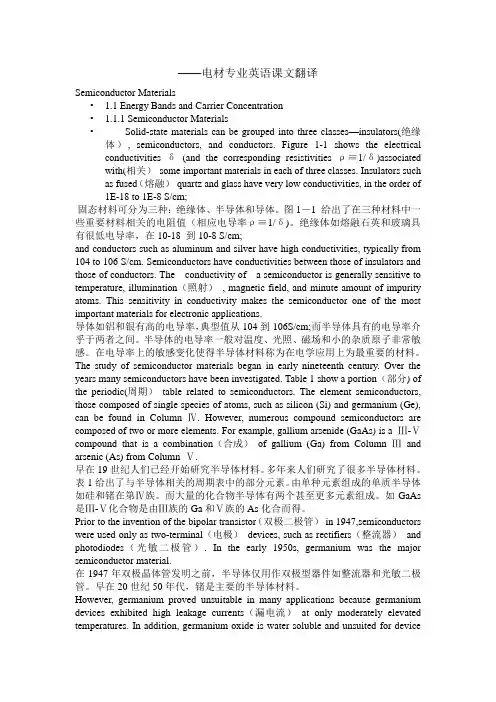
——电材专业英语课文翻译Semiconductor Materials• 1.1 Energy Bands and Carrier Concentration• 1.1.1 Semiconductor Materials•Solid-state materials can be grouped into three classes—insulators(绝缘体), semiconductors, and conductors. Figure 1-1 shows the electrical conductivities δ(and the corresponding resistivities ρ≡1/δ)associated with(相关)some important materials in each of three classes. Insulators such as fused(熔融)quartz and glass have very low conductivities, in the order of 1E-18 to 1E-8 S/cm;固态材料可分为三种:绝缘体、半导体和导体。
图1-1 给出了在三种材料中一些重要材料相关的电阻值(相应电导率ρ≡1/δ)。
绝缘体如熔融石英和玻璃具有很低电导率,在10-18 到10-8 S/cm;and conductors such as aluminum and silver have high conductivities, typically from 104 to 106 S/cm. Semiconductors have conductivities between those of insulators and those of conductors. The conductivity of a semiconductor is generally sensitive to temperature, illumination(照射), magnetic field, and minute amount of impurity atoms. This sensitivity in conductivity makes the semiconductor one of the most important materials for electronic applications.导体如铝和银有高的电导率,典型值从104到106S/cm;而半导体具有的电导率介乎于两者之间。
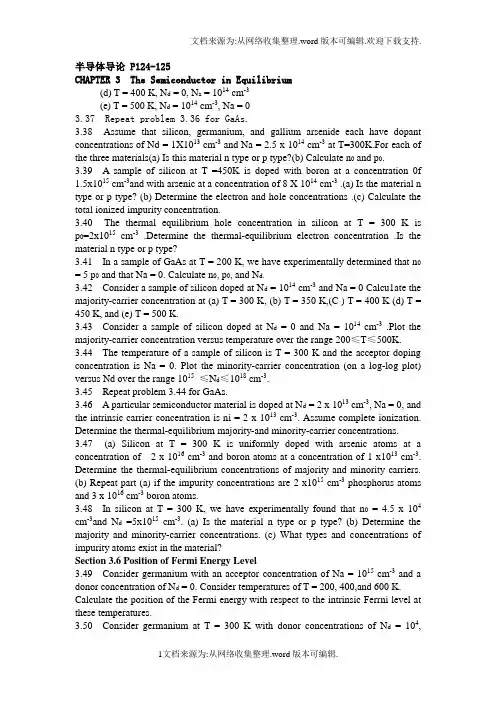
半导体导论 P124-125CHAPTER 3 The Semiconductor in Equilibrium(d) T = 400 K, N d = 0, N a = 1014 cm-3(e) T = 500 K, N d = 1014 cm-3, Na = 03.37 Repeat problem 3.36 for GaAs.3.38 Assume that silicon, germanium, and gallium arsenide each have dopant concentrations of Nd = 1X1013 cm-3 and Na = 2.5 x 1014 cm-3 at T=300K.For each of the three materials(a) Is this material n type or p type?(b) Calculate n0 and p0.3.39 A sample of silicon at T =450K is doped with boron at a concentration 0f 1.5x1015 cm-3and with arsenic at a concentration of 8 X 1014 cm-3 .(a) Is the material n type or p type? (b) Determine the electron and hole concentrations .(c) Calculate the total ionized impurity concentration.3.40 The thermal equilibrium hole concentration in silicon at T = 300 K is p0=2x1015cm-3.Determine the thermal-equilibrium electron concentration .Is the material n type or p type?3.41 In a sample of GaAs at T = 200 K, we have experimentally determined that n0 = 5 p0 and that Na = 0. Calculate n0, p0, and N d.3.42 Consider a sample of silicon doped at N d = 1014 cm-3 and Na = 0 Calcu1ate the majority-carrier concentration at (a) T = 300 K, (b) T = 350 K,(C ) T = 400 K (d) T = 450 K, and (e) T = 500 K.3.43 Consider a sample of silicon doped at N d= 0 and Na = 1014cm-3 .Plot the majority-carrier concentration versus temperature over the range 200≤T≤500K.3.44 The temperature of a sample of silicon is T = 300 K and the acceptor doping concentration is Na = 0. Plot the minority-carrier concentration (on a log-log plot) versus Nd over the range 1015≤N d≤1018 cm-3.3.45 Repeat problem 3.44 for GaAs.3.46 A particular semiconductor material is doped at N d = 2 x 1013 cm-3, Na = 0, and the intrinsic carrier concentration is ni = 2 x 1013 cm-3. Assume complete ionization. Determine the thermal-equilibrium majority-and minority-carrier concentrations.3.47 (a) Silicon at T = 300 K is uniformly doped with arsenic atoms at a concentration of 2 x 1016 cm-3 and boron atoms at a concentration of 1 x1013 cm-3. Determine the thermal-equilibrium concentrations of majority and minority carriers.(b) Repeat part (a) if the impurity concentrations are 2 x1015 cm-3 phosphorus atoms and 3 x 1016 cm-3 boron atoms.3.48 In silicon at T = 300 K, we have experimentally found that n0=4.5 x 104 cm-3and N d=5x1015cm-3. (a) Is the material n type or p type? (b) Determine the majority and minority-carrier concentrations. (c) What types and concentrations of impurity atoms exist in the material?Section 3.6 Position of Fermi Energy Level3.49 Consider germanium with an acceptor concentration of Na = 1015 cm-3 and a donor concentration of N d = 0. Consider temperatures of T = 200, 400,and 600 K. Calculate the position of the Fermi energy with respect to the intrinsic Ferrni level at these temperatures.3.50 Consider germanium at T = 300 K with donor concentrations of N d= 104,1016and1018 cm-3 .Let Na = 0. Calculate the position of the Fermi energy level with respect to the intrinsic Fermi level for these doping concentrations.3.51 A GaAs device is doped with a donor concentration of 3X1015cm-3 .For the device to operate properly ,the intrinsic carrier concentration must remain less than 5 percent of the total electron concentration .What is the maximum temperature that the device may operate?3.52 Consider germanium with an concentration of Na=1015cm-3and a donor concentration of N d=0.Plot the position of the Fermi energy with respect to the intrinsic Fermi level as a function of temperature over the range 200 ≤T ≤600 K. 3,53 Consider silicon at T =300K with Na=0. Plot the position of the Fermi energy with respect to the intrinsic Fermi level as a function of the donor doping concentration over the range 1014≤N d≤1018cm-3.3.54 For a particular semiconductor,Eg=1.50eV,m*p=10m*n,T=300K,and ni=105cm-3. (a)Determine the position of the intrinsic Fermi energy level with respect to the center of the bandgap. (b)Impurity atoms are added so that the Fermi energy level is 0.45eV below the center of the bandgap .(i)Are acceptor or donor atoms added? (ii)What is the concentration if impurity atoms added?3.55 Silicon at T = 300 K contains acceptor atoms at a concentration of Na = 5 x1015cm-3 . Donor atoms are add forming an n-type compensated semiconductor such that the Fermi level is 0.215 eV below the conduction band edge .What concentration of donor atoms are added?3.56 Silicon at T = 300 K is doped with acceptor atoms at a concentration of Na = 7 x1015cm-3. (a) Determine E f-E v. (b) Calculate the concentration of additional acceptor atoms that must be added to move the Fermi level a distance kT closer to the valence-band edge.3.57 (a) Determine the position of the Fermi level with respect to the intrinsic Fermi level in silicon at T = 300 K that is doped with phosphorus atoms at a concentration of 1015cm-3. (b) Repeat part (a) if the silicon is doped with boron atoms at a concentration of 1015cm-3. (c) Calculate the electron concentration in the silicon for parts (a) and (b).3.58 Gallium arsenide at T = 300 K contains acceptor impurity atoms at a density of 1015cm-3. Additional impurity atoms are to be added so that the Fermi level is 0.45 eV below the intrinsic level. Determine the concentration and type (donor or acceptor) of impurity atoms to be added.3.59 Determine the Fermi energy level with respect to the intrinsic Fermi level for each condition given in Problem 3.36.3.60 Find the Fermi energy level with respect to the valence band energy for the conditions given in Problem 3.37.3.61 Calculate the position of the Fermi energy level with respect to the intrinsic Fermi for the conditions given in Problem 3.48.Summary and Review3.62 A special semiconductor material is to be “designed. ” The semiconductor is tobe n type and doped with 1 x 1015 cm -3donor atoms . Assume complete ionization and assume N a=0. The effective density of states functions are givenby N c=N v=1.5x1019cm-3 and ate independent of temperature .A particular semiconductor device fabricated with this material requires the electron concentration to be no greater than 1.01x1019cm-3 at T=400K. What is the minimum value of the bandgap energy ?译文第三章半导体的平衡(d) T = 400 K, N d = 0, N a = 1014 cm-3(e) T = 500 K, N d = 1014 cm-3, Na = 03.37重复3.36砷化镓的问题3.38假设硅,锗,镓砷化物各有厘米的Nd = 1X1013 cm-3掺杂浓度和Na = 2.5 ×1014 cm-3在T = 300K. 对于每三种材料(一)这是N型还是P型材料?(二)计算N0和P0。
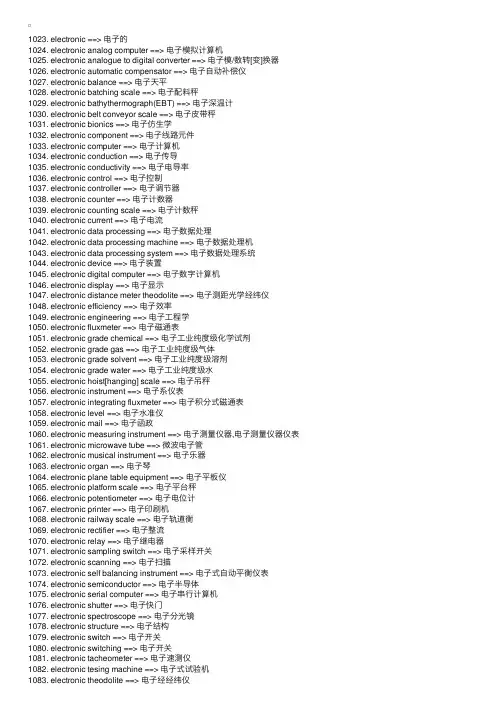
1023. electronic ==> 电⼦的1024. electronic analog computer ==> 电⼦模拟计算机1025. electronic analogue to digital converter ==> 电⼦模/数转[变]换器1026. electronic automatic compensator ==> 电⼦⾃动补偿仪1027. electronic balance ==> 电⼦天平1028. electronic batching scale ==> 电⼦配料秤1029. electronic bathythermograph(EBT) ==> 电⼦深温计1030. electronic belt conveyor scale ==> 电⼦⽪带秤1031. electronic bionics ==> 电⼦仿⽣学1032. electronic component ==> 电⼦线路元件1033. electronic computer ==> 电⼦计算机1034. electronic conduction ==> 电⼦传导1035. electronic conductivity ==> 电⼦电导率1036. electronic control ==> 电⼦控制1037. electronic controller ==> 电⼦调节器1038. electronic counter ==> 电⼦计数器1039. electronic counting scale ==> 电⼦计数秤1040. electronic current ==> 电⼦电流1041. electronic data processing ==> 电⼦数据处理1042. electronic data processing machine ==> 电⼦数据处理机1043. electronic data processing system ==> 电⼦数据处理系统1044. electronic device ==> 电⼦装置1045. electronic digital computer ==> 电⼦数字计算机1046. electronic display ==> 电⼦显⽰1047. electronic distance meter theodolite ==> 电⼦测距光学经纬仪1048. electronic efficiency ==> 电⼦效率1049. electronic engineering ==> 电⼦⼯程学1050. electronic fluxmeter ==> 电⼦磁通表1051. electronic grade chemical ==> 电⼦⼯业纯度级化学试剂1052. electronic grade gas ==> 电⼦⼯业纯度级⽓体1053. electronic grade solvent ==> 电⼦⼯业纯度级溶剂1054. electronic grade water ==> 电⼦⼯业纯度级⽔1055. electronic hoist[hanging] scale ==> 电⼦吊秤1056. electronic instrument ==> 电⼦系仪表1057. electronic integrating fluxmeter ==> 电⼦积分式磁通表1058. electronic level ==> 电⼦⽔准仪1059. electronic mail ==> 电⼦函政1060. electronic measuring instrument ==> 电⼦测量仪器,电⼦测量仪器仪表1061. electronic microwave tube ==> 微波电⼦管1062. electronic musical instrument ==> 电⼦乐器1063. electronic organ ==> 电⼦琴1064. electronic plane table equipment ==> 电⼦平板仪1065. electronic platform scale ==> 电⼦平台秤1066. electronic potentiometer ==> 电⼦电位计1067. electronic printer ==> 电⼦印刷机1068. electronic railway scale ==> 电⼦轨道衡1069. electronic rectifier ==> 电⼦整流1070. electronic relay ==> 电⼦继电器1071. electronic sampling switch ==> 电⼦采样开关1072. electronic scanning ==> 电⼦扫描1073. electronic self balancing instrument ==> 电⼦式⾃动平衡仪表1074. electronic semiconductor ==> 电⼦半导体1075. electronic serial computer ==> 电⼦串⾏计算机1076. electronic shutter ==> 电⼦快门1077. electronic spectroscope ==> 电⼦分光镜1078. electronic structure ==> 电⼦结构1079. electronic switch ==> 电⼦开关1080. electronic switching ==> 电⼦开关1081. electronic tacheometer ==> 电⼦速测仪1082. electronic tesing machine ==> 电⼦式试验机1083. electronic theodolite ==> 电⼦经经纬仪1084. electronic top loading balance ==> 电⼦上⽫天平1085. electronic trunk scale ==> 电⼦汽车秤1086. electronic tuning ==> 电⼦调谐1087. electronic voltage regulator ==> 电⼦电压调节器1088. electronics ==> 电⼦学1089. electronimage ==> 电⼦图象1090. electronmirror ==> 电⼦镜1091. electronoptical transducer ==> 电⼦光换能器1092. electrooptical deflector ==> 电光偏转器1093. electrooptical effect ==> 电光效应1094. electrooptical modulator ==> 电光调制器1095. electrooptical q switch ==> 电光q开关1096. electrooptical shutter ==> 电光快门1097. electrooptical technology ==> 光电技术1098. electrooptics ==> 电光学1099. electroosmosis ==> 电渗1100. electrophoresis ==> 电泳,电泳法1101. electrophoresis meter ==> 电泳仪1102. electrophorus ==> 起电盘1103. electrophysics ==> 电物理学1104. electrophysiology ==> 电⽓⽣理学1105. electroplating ==> 电解沉积,电镀1106. electropneumatic ==> 电空⽓压的1107. electropneumatic brake ==> 电动⽓动制动器1108. electropneumatic controller ==> 电动⽓动控制器1109. electropneumatic interlocking device ==> 电动⽓动联锁装置1110. electropneumatic switch ==> 电动⽓动开关1111. electropneumatic switch machine ==> 电动⽓动转接机1112. electropneumatic transducer ==> 电动⽓动变换器电⽓转换器1113. electropneumatic valve ==> 电动⽓动阀1114. electropolisher ==> 电解抛光机1115. electropolishing ==> 电解抛光1116. electrorefining ==> 电解精炼1117. electrorheograph ==> 电流1118. electroscope ==> 验电器1119. electroscopy ==> 验电法1120. electrosensitive printer ==> 电⽕化式印刷机1121. electrosonde ==> 电位探空仪1122. electrospark machining ==> 电⽕花加⼯1123. electrostatic ==> 静电的1124. electrostatic accelerater ==> 静电加速器1125. electrostatic actuator ==> 静电激发器1126. electrostatic analyzer ==> 静电分析器1127. electrostatic attraction ==> 静电吸引1128. electrostatic capacity ==> 静电电容1129. electrostatic charge ==> 静电电荷,静电荷1130. electrostatic coating ==> 静电喷涂1131. electrostatic coupling ==> 静电耦合1132. electrostatic deflection ==> 静电偏转1133. electrostatic discharge susceptibility symbol ==> 静电放电敏感性标志,为了识别静电放电敏感性产品,放置在硬件、部件和⽂件上的图形。
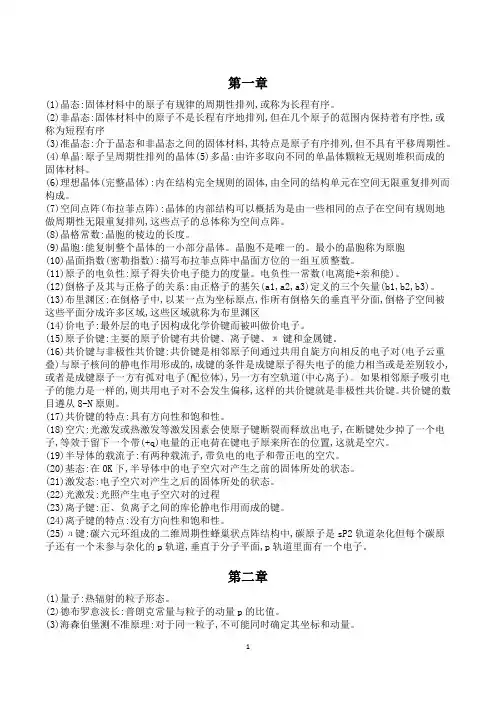
第一章(1)晶态:固体材料中的原子有规律的周期性排列,或称为长程有序。
(2)非晶态:固体材料中的原子不是长程有序地排列,但在几个原子的范围内保持着有序性,或称为短程有序(3)准晶态:介于晶态和非晶态之间的固体材料,其特点是原子有序排列,但不具有平移周期性。
(4)单晶:原子呈周期性排列的晶体(5)多晶:由许多取向不同的单晶体颗粒无规则堆积而成的固体材料。
(6)理想晶体(完整晶体):内在结构完全规则的固体,由全同的结构单元在空间无限重复排列而构成。
(7)空间点阵(布拉菲点阵):晶体的内部结构可以概括为是由一些相同的点子在空间有规则地做周期性无限重复排列,这些点子的总体称为空间点阵。
(8)晶格常数:晶胞的棱边的长度。
(9)晶胞:能复制整个晶体的一小部分晶体。
晶胞不是唯一的。
最小的晶胞称为原胞(10)晶面指数(密勒指数):描写布拉菲点阵中晶面方位的一组互质整数。
(11)原子的电负性:原子得失价电子能力的度量。
电负性一常数(电离能+亲和能)。
(12)倒格子及其与正格子的关系:由正格子的基矢(a1,a2,a3)定义的三个矢量(b1,b2,b3)。
(13)布里渊区:在倒格子中,以某一点为坐标原点,作所有倒格矢的垂直平分面,倒格子空间被这些平面分成许多区域,这些区域就称为布里渊区(14)价电子:最外层的电子因构成化学价键而被叫做价电子。
(15)原子价键:主要的原子价键有共价键、离子键、π键和金属键。
(16)共价键与非极性共价键:共价键是相邻原子间通过共用自旋方向相反的电子对(电子云重叠)与原子核间的静电作用形成的,成键的条件是成键原子得失电子的能力相当或是差别较小,或者是成键原子一方有孤对电子(配位体),另一方有空轨道(中心离子)。
如果相邻原子吸引电子的能力是一样的,则共用电子对不会发生偏移,这样的共价键就是非极性共价键。
共价键的数目遵从8-N原则。
(17)共价键的特点:具有方向性和饱和性。
(18)空穴:光激发或热激发等激发因素会使原子键断裂而释放出电子,在断键处少掉了一个电子,等效于留下一个带(+q)电量的正电荷在键电子原来所在的位置,这就是空穴。

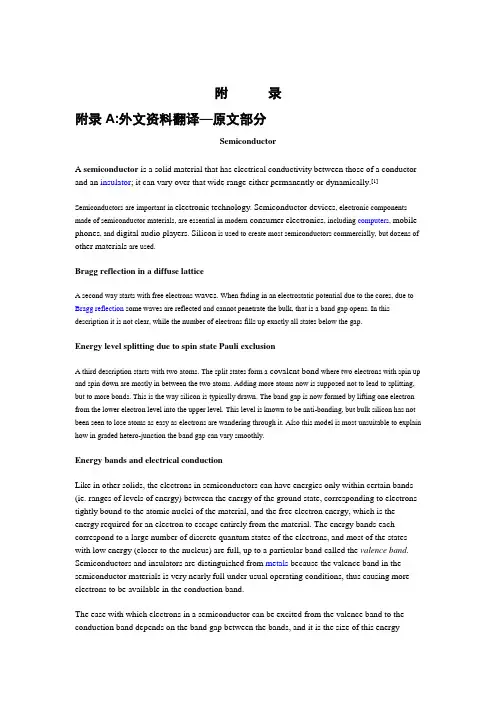
附录附录A:外文资料翻译—原文部分SemiconductorA semiconductor is a solid material that has electrical conductivity between those of a conductor and an insulator; it can vary over that wide range either permanently or dynamically.[1]Semiconductors are important in electronic technology. Semiconductor devices, electronic components made of semiconductor materials, are essential in modern consumer electronics, including computers, mobile phones, and digital audio players. Silicon is used to create most semiconductors commercially, but dozens of other materials are used.Bragg reflection in a diffuse latticeA second way starts with free electrons waves. When fading in an electrostatic potential due to the cores, due to Bragg reflection some waves are reflected and cannot penetrate the bulk, that is a band gap opens. In this description it is not clear, while the number of electrons fills up exactly all states below the gap.Energy level splitting due to spin state Pauli exclusionA third description starts with two atoms. The split states form a covalent bond where two electrons with spin up and spin down are mostly in between the two atoms. Adding more atoms now is supposed not to lead to splitting, but to more bonds. This is the way silicon is typically drawn. The band gap is now formed by lifting one electron from the lower electron level into the upper level. This level is known to be anti-bonding, but bulk silicon has not been seen to lose atoms as easy as electrons are wandering through it. Also this model is most unsuitable to explain how in graded hetero-junction the band gap can vary smoothly.Energy bands and electrical conductionLike in other solids, the electrons in semiconductors can have energies only within certain bands (ie. ranges of levels of energy) between the energy of the ground state, corresponding to electrons tightly bound to the atomic nuclei of the material, and the free electron energy, which is the energy required for an electron to escape entirely from the material. The energy bands each correspond to a large number of discrete quantum states of the electrons, and most of the states with low energy (closer to the nucleus) are full, up to a particular band called the valence band. Semiconductors and insulators are distinguished from metals because the valence band in the semiconductor materials is very nearly full under usual operating conditions, thus causing more electrons to be available in the conduction band.The ease with which electrons in a semiconductor can be excited from the valence band to the conduction band depends on the band gap between the bands, and it is the size of this energybandgap that serves as an arbitrary dividing line (roughly 4 eV) between semiconductors and insulators.In the picture of covalent bonds, an electron moves by hopping to a neighboring bond. Because of the Pauli exclusion principle it has to be lifted into the higher anti-bonding state of that bond. In the picture of delocalized states, for example in one dimension that is in a wire, for every energy there is a state with electrons flowing in one direction and one state for the electrons flowing in the other. For a net current to flow some more states for one direction than for the other direction have to be occupied and for this energy is needed. For a metal this can be a very small energy in the semiconductor the next higher states lie above the band gap. Often this is stated as: full bands do not contribute to the electrical conductivity. However, as the temperature of a semiconductor rises above absolute zero, there is more energy in the semiconductor to spend on lattice vibration and — more importantly for us — on lifting some electrons into an energy states of the conduction band, which is the band immediately above the valence band. The current-carrying electrons in the conduction band are known as "free electrons", although they are often simply called "electrons" if context allows this usage to be clear.Electrons excited to the conduction band also leave behind electron holes, or unoccupied states in the valence band. Both the conduction band electrons and the valence band holes contribute to electrical conductivity. The holes themselves don't actually move, but a neighboring electron can move to fill the hole, leaving a hole at the place it has just come from, and in this way the holes appear to move, and the holes behave as if they were actual positively charged particles.One covalent bond between neighboring atoms in the solid is ten times stronger than the binding of the single electron to the atom, so freeing the electron does not imply destruction of the crystal structure.Holes: electron absence as a charge carrierThe notion of holes, which was introduced for semiconductors, can also be applied to metals, where the Fermi level lies within the conduction band. With most metals the Hall effect reveals electrons to be the charge carriers, but some metals have a mostly filled conduction band, and the Hall effect reveals positive charge carriers, which are not the ion-cores, but holes. Contrast this to some conductors like solutions of salts, or plasma. In the case of a metal, only a small amount of energy is needed for the electrons to find other unoccupied states to move into, and hence for current to flow. Sometimes even in this case it may be said that a hole was left behind, to explain why the electron does not fall back to lower energies: It cannot find a hole. In the end in both materials electron-phonon scattering and defects are the dominant causes for resistance.Fermi-Dirac distribution. States with energy εbelow the Fermi energy, here μ, have higher probability n to be occupied, and those above are less likely to be occupied. Smearing of the distribution increases with temperature.The energy distribution of the electrons determines which of the states are filled and which are empty. This distribution is described by Fermi-Dirac statistics. The distribution is characterized bythe temperature of the electrons, and the Fermi energy or Fermi level. Under absolute zero conditions the Fermi energy can be thought of as the energy up to which available electron states are occupied. At higher temperatures, the Fermi energy is the energy at which the probability of a state being occupied has fallen to 0.5.The dependence of the electron energy distribution on temperature also explains why the conductivity of a semiconductor has a strong temperature dependency, as a semiconductor operating at lower temperatures will have fewer available free electrons and holes able to do the work.Energy–momentum dispersionIn the preceding description an important fact is ignored for the sake of simplicity: the dispersion of the energy. The reason that the energies of the states are broadened into a band is that the energy depends on the value of the wave vector, or k-vector, of the electron. The k-vector, in quantum mechanics, is the representation of the momentum of a particle.The dispersion relationship determines the effective mass, m* , of electrons or holes in the semiconductor, according to the formula:The effective mass is important as it affects many of the electrical properties of the semiconductor, such as the electron or hole mobility, which in turn influences the diffusivity of the charge carriers and the electrical conductivity of the semiconductor.Typically the effective mass of electrons and holes are different. This affects the relative performance of p-channel and n-channel IGFETs, for example (Muller & Kamins 1986:427).The top of the valence band and the bottom of the conduction band might not occur at that same value of k. Materials with this situation, such as silicon and germanium, are known as indirect bandgap materials. Materials in which the band extrema are aligned in k, for example gallium arsenide, are called direct bandgap semiconductors. Direct gap semiconductors are particularly important in optoelectronics because they are much more efficient as light emitters than indirect gap materials.Carrier generation and recombinationWhen ionizing radiation strikes a semiconductor, it may excite an electron out of its energy level and consequently leave a hole. This process is known as electron–hole pair generation.Electron-hole pairs are constantly generated from thermal energy as well, in the absence of any external energy source.Electron-hole pairs are also apt to recombine. Conservation of energy demands that these recombination events, in which an electron loses an amount of energy larger than the band gap, beaccompanied by the emission of thermal energy (in the form of phonons) or radiation (in the form of photons).In some states, the generation and recombination of electron–hole pairs are in equipoise. The number of electron-hole pairs in the steady state at a given temperature is determined by quantum statistical mechanics. The precise quantum mechanical mechanisms of generation and recombination are governed by conservation of energy and conservation of momentum.As the probability that electrons and holes meet together is proportional to the product of their amounts, the product is in steady state nearly constant at a given temperature, providing that there is no significant electric field (which might "flush" carriers of both types, or move them from neighbour regions containing more of them to meet together) or externally driven pair generation. The product is a function of the temperature, as the probability of getting enough thermal energy to produce a pair increases with temperature, being approximately 1×exp(−E G / kT), where k is Boltzmann's constant, T is absolute temperature and E G is band gap.The probability of meeting is increased by carrier traps – impurities or dislocations which can trap an electron or hole and hold it until a pair is completed. Such carrier traps are sometimes purposely added to reduce the time needed to reach the steady state.DopingThe property of semiconductors that makes them most useful for constructing electronic devices is that their conductivity may easily be modified by introducing impurities into their crystal lattice. The process of adding controlled impurities to a semiconductor is known as doping. The amount of impurity, or dopant, added to an intrinsic (pure) semiconductor varies its level of conductivity. Doped semiconductors are often referred to as extrinsic.DopantsThe materials chosen as suitable dopants depend on the atomic properties of both the dopant and the material to be doped. In general, dopants that produce the desired controlled changes are classified as either electron acceptors or donors. A donor atom that activates (that is, becomes incorporated into the crystal lattice) donates weakly-bound valence electrons to the material, creating excess negative charge carriers. These weakly-bound electrons can move about in the crystal lattice relatively freely and can facilitate conduction in the presence of an electric field. (The donor atoms introduce some states under, but very close to the conduction band edge. Electrons at these states can be easily excited to conduction band, becoming free electrons, at room temperature.) Conversely, an activated acceptor produces a hole. Semiconductors doped with donor impurities are called n-type, while those doped with acceptor impurities are known as p-type. The n and p type designations indicate which charge carrier acts as the material's majority carrier. The opposite carrier is called the minority carrier, which exists due to thermal excitation at a much lower concentration compared to the majority carrier.For example, the pure semiconductor silicon has four valence electrons. In silicon, the most common dopants are IUPAC group 13 (commonly known as group III) and group 15 (commonly known as group V) elements. Group 13 elements all contain three valence electrons, causing them to function as acceptors when used to dope silicon. Group 15 elements have five valence electrons, which allows them to act as a donor. Therefore, a silicon crystal doped with boron creates a p-type semiconductor whereas one doped with phosphorus results in ann-type material.Carrier concentrationThe concentration of dopant introduced to an intrinsic semiconductor determines its concentration and indirectly affects many of its electrical properties. The most important factor that doping directly affects is the material's carrier concentration. In an intrinsic semiconductor under thermal equilibrium, the concentration of electrons and holes is equivalent. That is,n = p = n iIf we have a non-intrinsic semiconductor in thermal equilibrium the relation becomes:n0 * p0 = (n i)2Where n is the concentration of conducting electrons, p is the electron hole concentration, and n i is the material's intrinsic carrier concentration. Intrinsic carrier concentration varies between materials and is dependent on temperature. Silicon's n i, for example, is roughly 1.6×1010 cm-3 at 300 kelvin (room temperature).In general, an increase in doping concentration affords an increase in conductivity due to the higher concentration of carriers available for conduction. Degenerately (very highly) doped semiconductors have conductivity levels comparable to metals and are often used in modern integrated circuits as a replacement for metal. Often superscript plus and minus symbols are used to denote relative doping concentration in semiconductors. For example, n+ denotes an n-type semiconductor with a high, often degenerate, doping concentration. Similarly, p−would indicate a very lightly doped p-type material. It is useful to note that even degenerate levels of doping imply low concentrations of impurities with respect to the base semiconductor. In crystalline intrinsic silicon, there are approximately 5×1022 atoms/cm³. Doping concentration for silicon semiconductors may range anywhere from 1013 cm-3 to 1018 cm-3. Doping concentration above about 1018 cm-3 is considered degenerate at room temperature. Degenerately doped silicon contains a proportion of impurity to silicon in the order of parts per thousand. This proportion may be reduced to parts per billion in very lightly doped silicon. Typical concentration values fall somewhere in this range and are tailored to produce the desired properties in the device that the semiconductor is intended for.Effect on band structureDoping a semiconductor crystal introduces allowed energy states within the band gap but very close to the energy band that corresponds with the dopant type. In other words, donor impurities create states near the conduction band while acceptors create states near the valence band. The gap between these energy states and the nearest energy band is usually referred to as dopant-sitebonding energy or E B and is relatively small. For example, the E B for boron in silicon bulk is0.045 eV, compared with silicon's band gap of about 1.12 eV. Because E B is so small, it takes little energy to ionize the dopant atoms and create free carriers in the conduction or valence bands. Usually the thermal energy available at room temperature is sufficient to ionize most of the dopant.Dopants also have the important effect of shifting the material's Fermi level towards the energy band that corresponds with the dopant with the greatest concentration. Since the Fermi level must remain constant in a system in thermodynamic equilibrium, stacking layers of materials with different properties leads to many useful electrical properties. For example, the p-n junction's properties are due to the energy band bending that happens as a result of lining up the Fermi levels in contacting regions of p-type and n-type material.This effect is shown in a band diagram. The band diagram typically indicates the variation in the valence band and conduction band edges versus some spatial dimension, often denoted x. The Fermi energy is also usually indicated in the diagram. Sometimes the intrinsic Fermi energy, E i, which is the Fermi level in the absence of doping, is shown. These diagrams are useful in explaining the operation of many kinds of semiconductor devices.Preparation of semiconductor materialsSemiconductors with predictable, reliable electronic properties are necessary for mass production. The level of chemical purity needed is extremely high because the presence of impurities even in very small proportions can have large effects on the properties of the material. A high degree of crystalline perfection is also required, since faults in crystal structure (such as dislocations, twins, and stacking faults) interfere with the semiconducting properties of the material. Crystalline faults are a major cause of defective semiconductor devices. The larger the crystal, the more difficult it is to achieve the necessary perfection. Current mass production processes use crystal ingots between four and twelve inches (300 mm) in diameter which are grown as cylinders and sliced into wafers.Because of the required level of chemical purity and the perfection of the crystal structure which are needed to make semiconductor devices, special methods have been developed to produce the initial semiconductor material. A technique for achieving high purity includes growing the crystal using the Czochralski process. An additional step that can be used to further increase purity is known as zone refining. In zone refining, part of a solid crystal is melted. The impurities tend to concentrate in the melted region, while the desired material recrystalizes leaving the solid material more pure and with fewer crystalline faults.In manufacturing semiconductor devices involving heterojunctions between different semiconductor materials, the lattice constant, which is the length of the repeating element of the crystal structure, is important for determining the compatibility of materials.附录B:外文资料翻译—译文部分半导体半导体是一种导电性能介于导体与绝缘体之间的固体材料。
semiconductors翻译基本解释●semiconductors:半导体●/ˌsem.i.kənˈdʌk.tərz/●n. 半导体变化形式●n. 复数形式:semiconductors具体用法●n.:o半导体o同义词:silicon devices, electronic components, microchips, transistors, integrated circuitso反义词:insulators, conductors, metals, non-conductors, dielectricso例句:●Semiconductors are essential components in modernelectronic devices, enabling the functionality of smartphones,computers, and many other gadgets. 半导体是现代电子设备中必不可少的组件,使智能手机、计算机和许多其他设备能够正常工作。
●The global semiconductor industry is a key driver oftechnological innovation and economic growth, with companies investing billions in research and development. 全球半导体行业是技术创新和经济增长的关键推动力,各公司在研发上投入了数十亿美元。
●Advances in semiconductor technology have led to thedevelopment of faster and more efficient electronic devices, transforming the way we live and work. 半导体技术的进步导致了更快、更高效的电子设备的发展,改变了我们的生活和工作方式。
第2单元电子基础第3课半导体材料通常,根据材料导电性能的不同,可分为三种类型——导体,半导体和绝缘体。
半导体是一种导电能力介于导体和绝缘体之间的材料,其导电性在外部电场的作用下是变化的。
半导体材料的导电性能比导体差,但是相对于绝缘体来说其导电性能比较好。
早在19世纪就开始对半导体材料进行研究,多年以来,许多半导体材料已经开发。
表1-1为半导体化学元素周期表的一部分。
元素半导体是由单一元素制成的半导体材料。
例如IV族元素硅、锗和锡和VI族元素硒和锑。
大多数化合物半导体材料由两种或两种以上元素组成。
如砷化镓是III-V族化合物。
它是由III族的镓元素和V族的砷元素组成。
由半导体材料制成的电子器件非常微小。
利用半导体材料的性质可以制造出功能多样的半导体器件。
另外,半导体器件和其他电子器件相比有很多优点,它们体积小、重量轻而且功耗小。
与其他电子器件一样,半导体器件有控制电子移动的能力。
可用作整流器、探测器、放大器、振荡器、电子开关、混频器和调制器等。
通常用于半导体器件的半导体材料是锗和硅,它们是应用最广的半导体材料。
锗和硅都属于金刚石晶格结构,这种结构同时也属于立方晶体族结构。
地球上超过90%的成分由二氧化硅和硅酸盐组成。
硅元素储量丰富,占地球上第二位。
在沙滩上闪闪发亮的就是硅石。
在自然界和工业的许多化合物中均发现有硅成份组成。
对工业技术来讲,最重要的就是硅是半导体器件的基础平台。
大多数的半导体器件都是由硅材料制造的,尤其是集成电路和微芯片。
在集成电路制造中,硅材料是形成单晶硅片的基础。
为了跟上集成电路制造工艺、芯片尺寸和电路复杂程度的步伐,硅晶体和晶圆也必须在增加直径的同时改善其性能。
现在普遍制造的硅片直径已经足够大,可以达到300mm也就是12inch。
图3-1中显示的是一片硅晶圆。
现代的特大规模集成电路,其设计工艺已经要求达到60纳米,这都是由于硅单晶具有非常良好的性质,而且这些硅片都是应用坩埚直拉法形成的。
半导体导论 P124-125CHAPTER 3 The Semiconductor in Equilibrium(d) T = 400 K, N d = 0, N a = 1014 cm-3(e) T = 500 K, N d = 1014 cm-3, Na = 03.37 Repeat problem 3.36 for GaAs.3.38 Assume that silicon, germanium, and gallium arsenide each have dopant concentrations of Nd = 1X1013 cm-3 and Na = 2.5 x 1014 cm-3 at T=300K.For each of the three materials(a) Is this material n type or p type?(b) Calculate n0 and p0.3.39 A sample of silicon at T =450K is doped with boron at a concentration 0f 1.5x1015 cm-3and with arsenic at a concentration of 8 X 1014 cm-3 .(a) Is the material n type or p type? (b) Determine the electron and hole concentrations .(c) Calculate the total ionized impurity concentration.3.40 The thermal equilibrium hole concentration in silicon at T = 300 K is p0=2x1015cm-3.Determine the thermal-equilibrium electron concentration .Is the material n type or p type?3.41 In a sample of GaAs at T = 200 K, we have experimentally determined that n0 = 5 p0 and that Na = 0. Calculate n0, p0, and N d.3.42 Consider a sample of silicon doped at N d = 1014 cm-3 and Na = 0 Calcu1ate the majority-carrier concentration at (a) T = 300 K, (b) T = 350 K,(C ) T = 400 K (d) T = 450 K, and (e) T = 500 K.3.43 Consider a sample of silicon doped at N d= 0 and Na = 1014cm-3 .Plot the majority-carrier concentration versus temperature over the range 200≤T≤500K.3.44 The temperature of a sample of silicon is T = 300 K and the acceptor doping concentration is Na = 0. Plot the minority-carrier concentration (on a log-log plot) versus Nd over the range 1015≤N d≤1018 cm-3.3.45 Repeat problem 3.44 for GaAs.3.46 A particular semiconductor material is doped at N d = 2 x 1013 cm-3, Na = 0, and the intrinsic carrier concentration is ni = 2 x 1013 cm-3. Assume complete ionization. Determine the thermal-equilibrium majority-and minority-carrier concentrations.3.47 (a) Silicon at T = 300 K is uniformly doped with arsenic atoms at a concentration of 2 x 1016 cm-3 and boron atoms at a concentration of 1 x1013 cm-3. Determine the thermal-equilibrium concentrations of majority and minority carriers.(b) Repeat part (a) if the impurity concentrations are 2 x1015 cm-3 phosphorus atoms and 3 x 1016 cm-3 boron atoms.3.48 In silicon at T = 300 K, we have experimentally found that n0=4.5 x 104 cm-3and N d=5x1015cm-3. (a) Is the material n type or p type? (b) Determine the majority and minority-carrier concentrations. (c) What types and concentrations of impurity atoms exist in the material?Section 3.6 Position of Fermi Energy Level3.49 Consider germanium with an acceptor concentration of Na = 1015 cm-3 and a donor concentration of N d = 0. Consider temperatures of T = 200, 400,and 600 K. Calculate the position of the Fermi energy with respect to the intrinsic Ferrni level at these temperatures.3.50 Consider germanium at T = 300 K with donor concentrations of N d= 104, 1016and1018 cm-3 .Let Na = 0. Calculate the position of the Fermi energy level with respect to the intrinsic Fermi level for these doping concentrations.3.51 A GaAs device is doped with a donor concentration of 3X1015cm-3 .For the device to operate properly ,the intrinsic carrier concentration must remain less than 5 percent of the total electron concentration .What is the maximum temperature that the device may operate?3.52 Consider germanium with an concentration of Na=1015cm-3and a donor concentration of N d=0.Plot the position of the Fermi energy with respect to the intrinsic Fermi level as a function of temperature over the range 200 ≤T ≤600 K.3,53 Consider silicon at T =300K with Na=0. Plot the position of the Fermi energy with respect to the intrinsic Fermi level as a function of the donor doping concentration over the range 1014≤N d≤1018cm-3.3.54 For a particular semiconductor,Eg=1.50eV,m*p=10m*n,T=300K,and ni=105cm-3. (a)Determine the position of the intrinsic Fermi energy level with respect to the center of the bandgap. (b)Impurity atoms are added so that the Fermi energy level is 0.45eV below the center of the bandgap .(i)Are acceptor or donor atoms added? (ii)What is the concentration if impurity atoms added?3.55 Silicon at T = 300 K contains acceptor atoms at a concentration of Na = 5 x1015cm-3 . Donor atoms are add forming an n-type compensated semiconductor such that the Fermi level is 0.215 eV below the conduction band edge .What concentration of donor atoms are added?3.56 Silicon at T = 300 K is doped with acceptor atoms at a concentration of Na = 7 x1015cm-3. (a) Determine E f-E v. (b) Calculate the concentration of additional acceptor atoms that must be added to move the Fermi level a distance kT closer to thevalence-band edge.3.57 (a) Determine the position of the Fermi level with respect to the intrinsic Fermi level in silicon at T = 300 K that is doped with phosphorus atoms at a concentration of 1015cm-3. (b) Repeat part (a) if the silicon is doped with boron atoms at a concentration of 1015cm-3. (c) Calculate the electron concentration in the silicon for parts (a) and (b).3.58 Gallium arsenide at T = 300 K contains acceptor impurity atoms at a density of 1015cm-3. Additional impurity atoms are to be added so that the Fermi level is 0.45 eV below the intrinsic level. Determine the concentration and type (donor or acceptor) of impurity atoms to be added.3.59 Determine the Fermi energy level with respect to the intrinsic Fermi level for each condition given in Problem 3.36.3.60 Find the Fermi energy level with respect to the valence band energy for the conditions given in Problem 3.37.3.61 Calculate the position of the Fermi energy level with respect to the intrinsic Fermi for the conditions given in Problem 3.48.Summary and Review3.62 A special semiconductor material is to be “designed. ” The semiconductor is tobe n type and doped with 1 x 1015 cm -3donor atoms . Assume complete ionization and assume N a=0. The effective density of states functions are given by N c=N v=1.5x1019cm-3 and ate independent of temperature .A particular semiconductor device fabricated with this material requires the electron concentration to be no greater than 1.01x1019cm-3 at T=400K. What is the minimum value of the bandgap energy ?译文第三章半导体的平衡(d) T = 400 K, N d = 0, N a = 1014 cm-3(e) T = 500 K, N d = 1014 cm-3, Na = 03.37重复3.36砷化镓的问题3.38假设硅,锗,镓砷化物各有厘米的Nd = 1X1013 cm-3掺杂浓度和Na = 2.5 ×1014 cm-3在T = 300K. 对于每三种材料(一)这是N型还是P型材料?(二)计算N0和P0。
semiconductors 翻译基本解释●semiconductors:半导体●/ˌsem.i.kənˈdʌk.tər/●n. 一种材料,其导电性介于导体和绝缘体之间变化形式●n. 复数形式:semiconductors具体用法●名词:o意思: 一种材料,其导电性介于导体和绝缘体之间o同义词: silicon, germanium, semiconductor material, chip, wafer o反义词: insulator, nonconductor, dielectric, isolator, nonconductor o例句:●Semiconductors are essential components in modernelectronic devices, enabling the functionality of computersand smartphones. (半导体是现代电子设备中的关键组件,使计算机和智能手机的功能得以实现。
)●The global demand for semiconductors has surged due to theincreasing reliance on technology in everyday life. (由于日常生活中对技术的依赖增加,全球对半导体的需求激增。
)●Researchers are constantly exploring new materials toimprove the efficiency of semiconductors. (研究人员不断探索新材料以提高半导体的效率。
)●The semiconductor industry is a major driver of economicgrowth in many countries. (半导体行业是许多国家经济增长的主要推动力。
)●Advances in semiconductor technology have led to smallerand more powerful electronic devices. (半导体技术的进步导致了更小更强大的电子设备。
半导体器件导论下载温馨提示:该文档是我店铺精心编制而成,希望大家下载以后,能够帮助大家解决实际的问题。
文档下载后可定制随意修改,请根据实际需要进行相应的调整和使用,谢谢!并且,本店铺为大家提供各种各样类型的实用资料,如教育随笔、日记赏析、句子摘抄、古诗大全、经典美文、话题作文、工作总结、词语解析、文案摘录、其他资料等等,如想了解不同资料格式和写法,敬请关注!Download tips: This document is carefully compiled by the editor. I hope that after you download them, they can help yousolve practical problems. The document can be customized and modified after downloading, please adjust and use it according to actual needs, thank you!In addition, our shop provides you with various types of practical materials, such as educational essays, diary appreciation, sentence excerpts, ancient poems, classic articles, topic composition, work summary, word parsing, copy excerpts,other materials and so on, want to know different data formats and writing methods, please pay attention!半导体器件是现代电子设备中不可或缺的重要组成部分,它已经成为电子工业发展的基石。
半导体导论 P124-125CHAPTER 3 The Semiconductor in Equilibrium(d) T = 400 K, N d = 0, N a = 1014 cm-3(e) T = 500 K, N d = 1014 cm-3, Na = 03.37 Repeat problem 3.36 for GaAs.3.38 Assume that silicon, germanium, and gallium arsenide each have dopant concentrations of Nd = 1X1013 cm-3 and Na = 2.5 x 1014 cm-3 at T=300K.For each of the three materials(a) Is this material n type or p type?(b) Calculate n0 and p0.3.39 A sample of silicon at T =450K is doped with boron at a concentration 0f 1.5x1015 cm-3and with arsenic at a concentration of 8 X 1014 cm-3 .(a) Is the material n type or p type? (b) Determine the electron and hole concentrations .(c) Calculate the total ionized impurity concentration.3.40 The thermal equilibrium hole concentration in silicon at T = 300 K is p0=2x1015cm-3.Determine the thermal-equilibrium electron concentration .Is the material n type or p type?3.41 In a sample of GaAs at T = 200 K, we have experimentally determined that n0 = 5 p0 and that Na = 0. Calculate n0, p0, and N d.3.42 Consider a sample of silicon doped at N d = 1014 cm-3 and Na = 0 Calcu1ate the majority-carrier concentration at (a) T = 300 K, (b) T = 350 K,(C ) T = 400 K (d) T = 450 K, and (e) T = 500 K.3.43 Consider a sample of silicon doped at N d= 0 and Na = 1014cm-3 .Plot the majority-carrier concentration versus temperature over the range 200≤T≤500K.3.44 The temperature of a sample of silicon is T = 300 K and the acceptor doping concentration is Na = 0. Plot the minority-carrier concentration (on a log-log plot) versus Nd over the range 1015≤N d≤1018 cm-3.3.45 Repeat problem 3.44 for GaAs.3.46 A particular semiconductor material is doped at N d = 2 x 1013 cm-3, Na = 0, and the intrinsic carrier concentration is ni = 2 x 1013 cm-3. Assume complete ionization. Determine the thermal-equilibrium majority-and minority-carrier concentrations.3.47 (a) Silicon at T = 300 K is uniformly doped with arsenic atoms at a concentration of 2 x 1016 cm-3 and boron atoms at a concentration of 1 x1013 cm-3. Determine the thermal-equilibrium concentrations of majority and minority carriers.(b) Repeat part (a) if the impurity concentrations are 2 x1015 cm-3 phosphorus atoms and 3 x 1016 cm-3 boron atoms.3.48 In silicon at T = 300 K, we have experimentally found that n0=4.5 x 104 cm-3and N d=5x1015cm-3. (a) Is the material n type or p type? (b) Determine the majority and minority-carrier concentrations. (c) What types and concentrations of impurity atoms exist in the material?Section 3.6 Position of Fermi Energy Level3.49 Consider germanium with an acceptor concentration of Na = 1015 cm-3 and a donor concentration of N d = 0. Consider temperatures of T = 200, 400,and 600 K. Calculate the position of the Fermi energy with respect to the intrinsic Ferrni level at these temperatures.3.50 Consider germanium at T = 300 K with donor concentrations of N d= 104, 1016and1018 cm-3 .Let Na = 0. Calculate the position of the Fermi energy level with respect to the intrinsic Fermi level for these doping concentrations.3.51 A GaAs device is doped with a donor concentration of 3X1015cm-3 .For the device to operate properly ,the intrinsic carrier concentration must remain less than 5 percent of the total electron concentration .What is the maximum temperature that the device may operate?3.52 Consider germanium with an concentration of Na=1015cm-3and a donor concentration of N d=0.Plot the position of the Fermi energy with respect to the intrinsic Fermi level as a function of temperature over the range 200 ≤T ≤600 K.3,53 Consider silicon at T =300K with Na=0. Plot the position of the Fermi energy with respect to the intrinsic Fermi level as a function of the donor doping concentration over the range 1014≤N d≤1018cm-3.3.54 For a particular semiconductor,Eg=1.50eV,m*p=10m*n,T=300K,and ni=105cm-3. (a)Determine the position of the intrinsic Fermi energy level with respect to the center of the bandgap. (b)Impurity atoms are added so that the Fermi energy level is 0.45eV below the center of the bandgap .(i)Are acceptor or donor atoms added? (ii)What is the concentration if impurity atoms added?3.55 Silicon at T = 300 K contains acceptor atoms at a concentration of Na = 5 x1015cm-3 . Donor atoms are add forming an n-type compensated semiconductor such that the Fermi level is 0.215 eV below the conduction band edge .What concentration of donor atoms are added?3.56 Silicon at T = 300 K is doped with acceptor atoms at a concentration of Na = 7 x1015cm-3. (a) Determine E f-E v. (b) Calculate the concentration of additional acceptor atoms that must be added to move the Fermi level a distance kT closer to thevalence-band edge.3.57 (a) Determine the position of the Fermi level with respect to the intrinsic Fermi level in silicon at T = 300 K that is doped with phosphorus atoms at a concentration of 1015cm-3. (b) Repeat part (a) if the silicon is doped with boron atoms at a concentration of 1015cm-3. (c) Calculate the electron concentration in the silicon for parts (a) and (b).3.58 Gallium arsenide at T = 300 K contains acceptor impurity atoms at a density of 1015cm-3. Additional impurity atoms are to be added so that the Fermi level is 0.45 eV below the intrinsic level. Determine the concentration and type (donor or acceptor) of impurity atoms to be added.3.59 Determine the Fermi energy level with respect to the intrinsic Fermi level for each condition given in Problem 3.36.3.60 Find the Fermi energy level with respect to the valence band energy for the conditions given in Problem 3.37.3.61 Calculate the position of the Fermi energy level with respect to the intrinsic Fermi for the conditions given in Problem 3.48.Summary and Review3.62 A special semiconductor material is to be “designed. ” The semiconductor is tobe n type and doped with 1 x 1015 cm -3donor atoms . Assume complete ionization and assume N a=0. The effective density of states functions are given by N c=N v=1.5x1019cm-3 and ate independent of temperature .A particular semiconductor device fabricated with this material requires the electron concentration to be no greater than 1.01x1019cm-3 at T=400K. What is the minimum value of the bandgap energy ?译文第三章半导体的平衡(d) T = 400 K, N d = 0, N a = 1014 cm-3(e) T = 500 K, N d = 1014 cm-3, Na = 03.37重复3.36砷化镓的问题3.38假设硅,锗,镓砷化物各有厘米的Nd = 1X1013 cm-3掺杂浓度和Na = 2.5 ×1014 cm-3在T = 300K. 对于每三种材料(一)这是N型还是P型材料?(二)计算N0和P0。